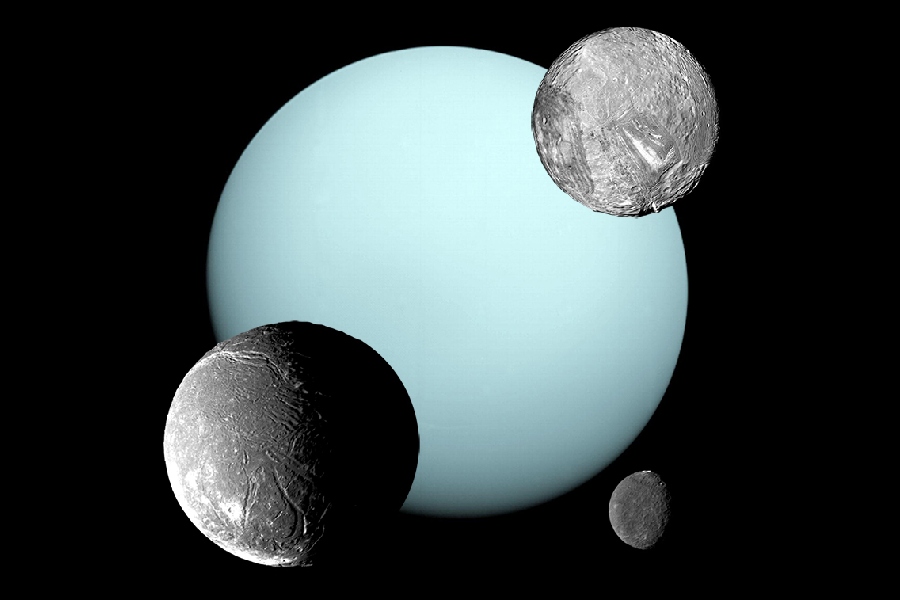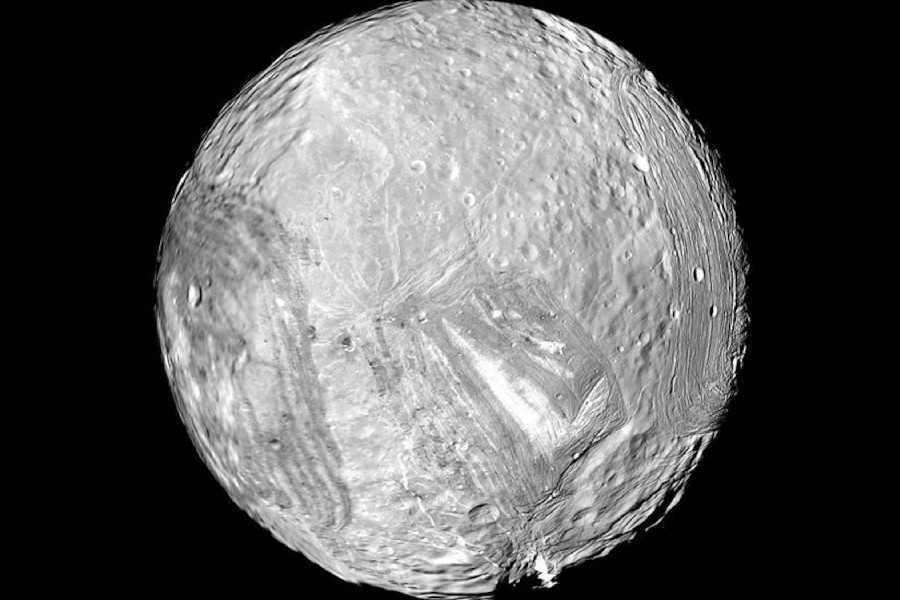With its unique rotation and unusual moons, Uranus is one of the most fascinating planets in our solar system. The ice giant’s satellite system holds many mysteries we have yet to unravel. In this article, we will dive into some of the most fascinating Uranus moons facts that showcase their weird, unexpected, and unique properties. We will discuss how Uranus ended up with such an odd assortment of satellites compared to other gas giants.
The article explores the misfit grouping of regular and irregular moons around the planet. We will also cover major moons like Titania, Oberon, Umbriel and Miranda and highlight their distinctive features.
With many puzzles yet to be solved, Uranus’ moons provide insights into the origins of icy worlds in the outer solar system. We hope this guide to essential facts intrigues you to learn more about these remote and remarkable moons.
Uranus Moons Facts
Uranus, the seventh planet from the Sun, has 27 known moons, including the five major ones — Miranda, Ariel, Umbriel, Titania, and Oberon. Miranda is particularly intriguing due to its varied and unique surface features, suggesting geological activity.
These moons are primarily composed of water, ice, and rock. Uranus’ moons are relatively small compared to those of other gas giants. Their discovery and detailed study have largely been facilitated by space probes like Voyager 2, which provided valuable data during its flyby in 1986.

Major Moons
Uranus’ five major moons – Titania, Oberon, Umbriel, Ariel, and Miranda – are icy worlds with distinctive features that provide insights into the Uranian system.
Diverse Surfaces and Origins
Titania, the largest at 788 miles wide, has a cratered, canyon-riven surface, while the the second-largest, Oberon, shows chasms and debris flowing across its 761-mile diameter icy exterior. Dark-surfaced Umbriel is pockmarked by craters and high cliffs.
Ariel has a ridged, geologically active surface covered in methane ice. Each moon has characteristics shaped by their formation from the accretion disk surrounding Uranus over four billion years ago and subsequent tidal heating that may have created subsurface oceans.
Since their discovery, starting with Titania and Oberon in 1787, these major Uranian moons have revealed unique attributes of distant icy worlds formed long ago around the tilted gas giant. Discoveries continue today on these remote, remarkable moons orbiting the unusual planet Uranus.
Titania
Titania is the largest of Uranus’ moons, with a diameter of 788 miles. Its surface is cratered with long canyons and faults, composed of mostly water ice with some rock. Titania reflects only about 20% of sunlight, giving it a reddish-dark color.
As the largest Uranian moon, Titania provides clues about Uranus’ tilt and the moon’s formation from its accretion disk. Its size also means it accounts for almost 99% of the mass orbiting Uranus from its rings and moons. Titania was discovered in 1787 and orbits Uranus once every 8.7 days.
Oberon
With a diameter of 761 miles, Oberon is the second largest of Uranus’ moons. Its surface of water ice, carbon dioxide, and darkened material is scarred by chasms, grooves, and debris flows.
Oberon’s cratered, radiation-absorbed landscape hints at past geologic activity and its origin from Uranus’ accretion disk over 4 billion years ago. Discovered in 1787, this darkly colored, distant moon provides valuable insights into Uranus’ unique system and early history.
Umbriel
With a diameter of 584 miles, Umbriel is one of the darkest moons orbiting Uranus. Its surface of dust and darkened material over icy bedrock is marked by ancient craters and canyons. Umbriel reflects only 16% of sunlight due to this lag deposit accumulated over billions of years.
The moon formed with Uranus but showed signs of later internal activity that uplifted parts of its crust, likely creating a subsurface ocean from tidal heating. This distant, icy body provides evidence of Umbriel’s geology and evolution around the ice giant.
Ariel
With a diameter of 587 miles, Ariel is one of Uranus’ mid-sized icy satellites. Its surface of water, ice, and methane shows signs of past geological activity that uplifted and modified its crust. Ariel has long ridges, large craters, and canyons across its surface.
Discovered in 1851, Ariel formed from the debris disk around newly-formed Uranus over 4 billion years ago. As part of Uranus’ moon system, the bright and complex Ariel gives insights into these distant satellites orbiting the tilted ice giant.
Miranda
Miranda, a major moon discovered by Gerard P. Kuiper, named after the character in the play The Tempest by William Shakespeare, is the innermost and the smallest of Uranus’ major moons. It has a complex, jumbled terrain that suggests a violent collisional history. Miranda’s surface features ridges, canyons, and cratered regions. It may have an internal structure made of differentiated layers.
Outer Moons
The outer moons of Uranus, including Cordelia, Ophelia, Bianca, Cressida, Desdemona, Juliet, Portia, Rosalind, and Cupid, share common traits and play an important role in understanding the Uranian system.
Overview of the outer moons
These ten small, icy moons orbit at great distances from Uranus and have irregular, elongated shapes. They likely originated from the debris disk around Uranus during its formation and have very dark surfaces, orbiting in the same direction as Uranus rotates.
Significance of the outer moons
The outer moons provide insights into icy body formation and Uranus’ history and tilt. They allow comparisons to other outer planet systems.
Some outer moons may preserve early geological and collisional history in their battered surfaces. Studying their geologic features and processes could uncover clues to icy satellite development over billions of years, expanding knowledge of ice worlds.

Notable Moons of Uranus: Diverse Unusual Worlds Up Close
Cordelia
Cordelia is Uranus’ innermost moon. It has a dark surface and is elongated in shape, with a possible rocky core. Cordelia orbits very close to Uranus’ ring system. It may contribute material to the epsilon ring.
Ophelia
Ophelia is small, irregularly shaped, and a very dark outer moon. It has a backward orbit compared to other Uranian moons. Ophelia appears to be coated in dark material that may come from radiation processing of surface ices.
Bianca
Bianca is another small, irregularly shaped outer moon. It has retrograde rotation and is likely composed of water ice with some silicate rock in its interior. Bianca’s surface is less dark than other small Uranian moons.
Cressida
Cressida is a small outer moon with a dark surface, likely composed of organic compounds. It has an elongated, irregular shape from its collisional history. Cressida orbits within Uranus’ epsilon ring and may supply ring particles.
Desdemona
Desdemona is a closely packed binary object, meaning it is composed of two separate moonlets orbiting very close together. It has a synchronous rotation, with the leading component slightly larger than the other.
Juliet
Juliet is a small outer moon, only about 50 km in diameter. It has a dark surface and is elongated in shape, with prograde rotation around Uranus. Juliet was likely created from the debris of a larger moon.
Portia
Portia is the outermost of Uranus’ round, regular-shaped moons. It rotates synchronously with a possible differentiation between rocky core and icy mantle. Portia is a reddish color likely caused by bombardment of charged particles.
Rosalind
Rosalind is the second-largest Uranian moon with a dim, dusty surface. It may possibly harbor a subsurface ocean. Rosalind has a faint ring system and orbits within the epsilon ring of Uranus.
Cupid
Cupid is Uranus’ smallest and outermost moon, only about 10 km in diameter. It was discovered in 2003 and had a backward orbit relative to Uranus’ rotation. Cupid is highly irregularly shaped.
Irregular Uranus Moons Facts
The four irregular moons of Uranus have orbits, unlike the planet’s larger regular satellites. Margaret, Prospero, Setebos, and Stephano follow distant, highly inclined, and eccentric paths around Uranus.
Orbits of the irregular moons
The four irregular moons have retrograde, tilted, and elliptical orbits, unlike Uranus’ regular moons. Margaret has the most eccentric orbit. The irregulars take over a year to orbit Uranus once. Their distant orbits suggest they were captured rather than forming near Uranus.
Size and features
The irregular moons of Uranus are relatively small, with diameters less than 50 km. They have very dark surfaces likely composed of a mixture of rock and ice. There is little known about their physical features since the irregulars have only been observed as faint points of light from Earth.
Conclusion
This tour through Uranus moons facts has hopefully provided greater understanding of this unique system of satellites orbiting the tilted seventh planet. We’ve covered details on the planet’s 27 known moons.
These range from the 5 major moons – Miranda, Ariel, Umbriel, Titania and Oberon – to the many smaller inner and outer moons, and distant irregular moons like Margaret and Prospero.
Their varying orbits, compositions, features, and significance within the Uranian system showcase the diversity of moons that developed around the ice giant as our knowledge of Uranus moons continues to grow with future exploration and observation.
